To understand the concept of Dither Fish you need to consider how a fish in nature perceives its environment.
While most fish aren’t sociable by mammal standards, they are definitely observant. Other fish, both of the same and different species, swimming about signals a safe environment – there aren’t likely to be predators around if schools of small fish are swimming in open water.
However, the moment those small fish scatter in fright, other fish take that as a signal to be on alert and flee, even if they are larger or of a different species. No fish whatsoever signals the imminent presence of a predator.
Imagine if you stepped out onto the streets of Manhattan and there was no one around. What sort of fears would pop into your head?
Soothing that instinct for community is why dither fish are important.
When no Dither Fish are present, it can create a sense of isolation and unease. Fish will show paler colors, timid behaviors, and diminished feeding responses.
All of this is species dependent; many large predatory fish will do well in single enclosures.
Providing Dither Fish for large predators provides mental stimulation in a small enclosure and more opportunities for you to observe intriguing behaviors from your pets.
When Should I Include Dither Fish?
Any time you intend on having a focal species for an aquarium its a good idea to provide Dither Fish.
Discus aquariums are a good example; while Discus are large, showy, expensive fish, Cardinal Tetras are ideal Dither Fish for them. They signal to Discus that all is well and have identical water quality requirements.
Cardinal Tetras also happen to be incredibly beautiful in groups and are much different in form, adding contrast.
If you have a community tank with just a few larger show specimens Dither Fish can serve the same purpose.
Regardless of the community type, Dither Fish add a sense of safety and contrast against the main inhabitants.
Dither Fish vs. Target Fish
While Dither Fish can also be Target Fish, it’s important to clarify the purpose of each.
Target Fish are meant to take on and diffuse some of the aggression that many fish will direct towards others of the same species.
Cichlids kept in small groups or pairs need an outlet for the constant tension they experience. As social animals there will always be a degree of lip locking, fin displays, and nips that occur.
Target Fish also help Cichlids solidify their territorial boundaries without feeling constantly challenged by their tank mates. And when trying to breed them, all of these displays intensify.
Even if both animals are receptive, keeping a pair of Cichlids in an isolated aquarium creates stress due to the lack of Dither Fish signalling a safe environment.
Also, they can only direct their sexual interest, aggression, and defensive attitudes towards each other, sometimes to fatal results.
Cichlids are excellent parents that defend their eggs and fry from predators.
When Target Fish are provided that occupy the upper middle and upper water column, the pair can direct their natural parental instincts towards these “intruders.” So long as the tank is spacious and you choose the right Target Fish, no lasting harm will be done.
Lastly, Target Fish also act as Dither Fish and signal a lack of predators nearby, further reducing stress for all inhabitants.
Small Dither Fish Species
Here are a few small types of dither fish that we recommend:
Tetras
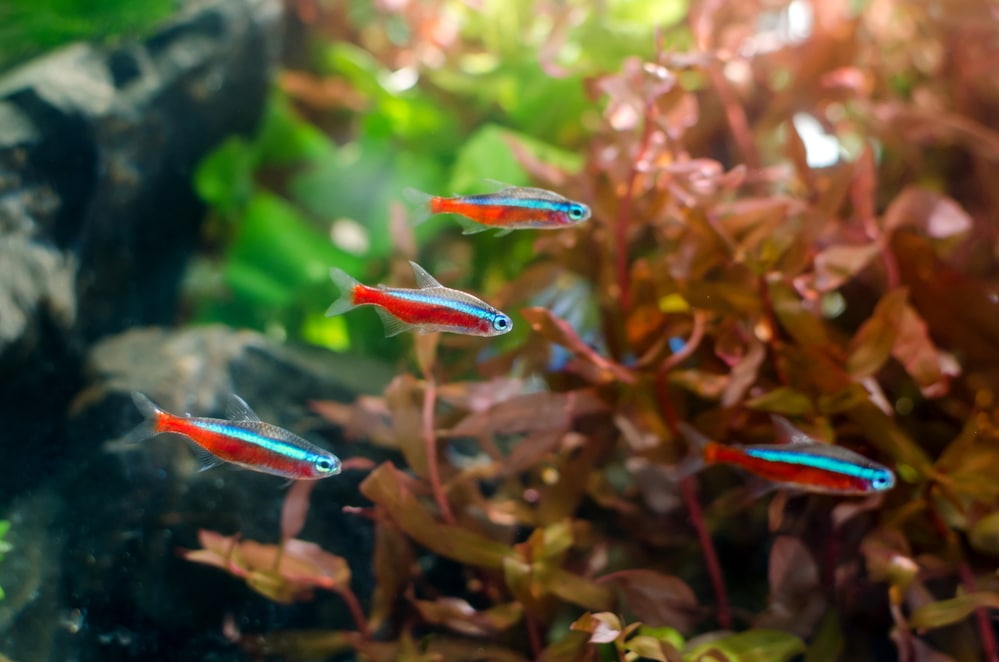
Tetras are Characins, one of the most diverse groups of fish in the world. Characins include the fearsome Piranha, the giant Pacu, and the familiar Neon Tetra. Characins as a whole are schooling fish that make excellent Dither and Target Fish.
Tetras are mostly small fish and should not be used as Target Fish unless their tank mates are also small and the aquarium is spacious. Bettas, Dwarf Cichlids, and Paradise Fish are tank mates that will benefit from their Dither and Target Fish capacity while being unable to actually catch a Tetra.
Tetras are all carnivorous and should be fed a mixture of prepared flakes, appropriately sized pellets, and live and frozen foods. Foods that contain carotenoids like brine shrimp and bloodworms will help enhance the reds and golds so common to Tetra species.
- Average Length: 1-3″
- pH Requirements:0-7.0
- Water Column: Middle
- Species to Consider: Cardinal Tetras, Neon Tetras, Diamond Tetras, Glowlight Tetras,
- Special Considerations: Tetras come from South America and as a whole prefer especially warm, slightly acidic waters. Many captive bred Tetras are more flexible but others will suffer in cool or alkaline aquariums.
- My Recommendation: Neon Tetras
Neon Tetras are inexpensive, attractive, and hardy. Having been captive bred for decades, they can tolerate a wider range of water conditions than Cardinal Tetras. Neon Tetras will accept any prepared or frozen foods offered and rarely top 1½ inches.
Danios
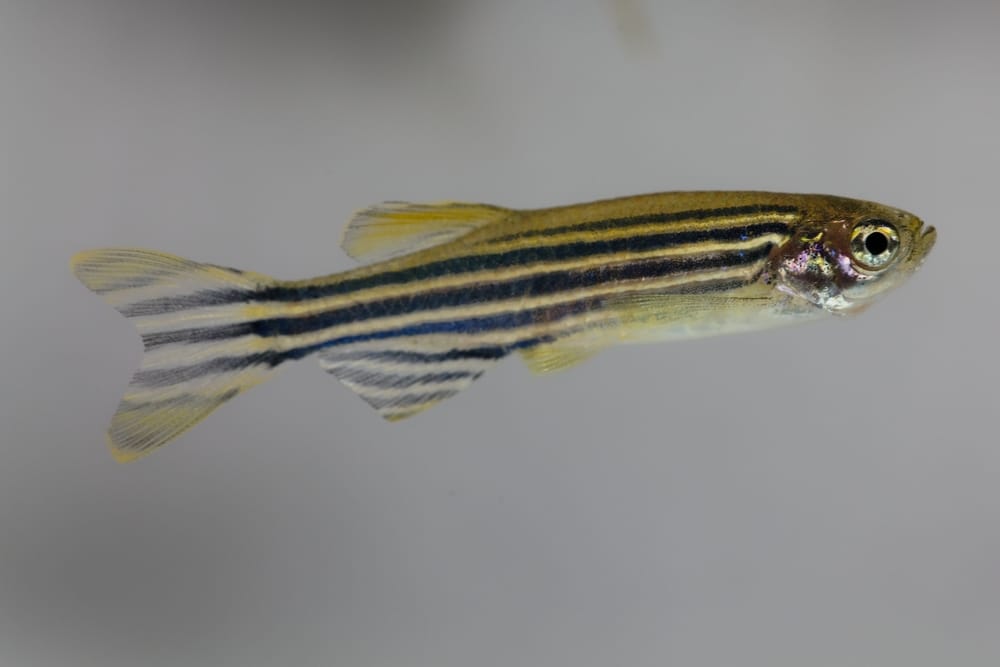
Danios are another diverse group of fish, though as Cyprinids they are in the Carp family and related to Goldfish, Koi, and Barbs. Danios are exclusively from Southeast Asia but are almost entirely captive bred nowadays. They are peaceful schooling fish that mix well with anything that won’t eat them and will happily take flakes, pellets, and anything else offered.
Many of the more commonly available Danios come in several color morphs, including Albino and Leucistic forms. Unlike Tetras some Danios such as Zebras are cool water tolerant and thrive in unheated aquariums.Danios are easy to breed as well, scattering their eggs in tangled aquatic plants when well fed and kept in groups.
- Average Length: 1-2″
- pH Requirements:0-7.5
- Water Column: Middle to Upper
- Species to Consider: Cardinal,
- Special Considerations: Zebra Danio, Pearl Danio, Glowlight Danio, Celestial Pearl Danio
- My Recommendation: Zebra Danios
Zebra Danios are immensely popular for good reason. They come in several color morphs, from albino and leopard spotted to a unique, genetically engineered “GloFish” that fluoresce in red, green, and yellow. Zebra Danios are hardy, available in pet stores around the world, and add just the right amount of action to the middle and upper water column.
Hatchetfish
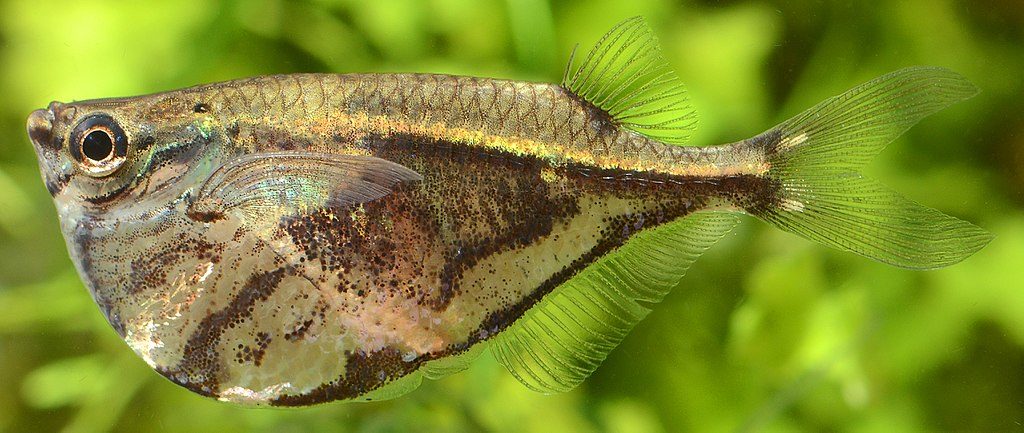
Hatchetfish are Characins like Tetras and thus schooling fish. Native to South America, Hatchetfish live up to their name, with a thin, hatchet shaped body that serves a very special purpose. Not only can they cut through the water with immense speed, Hatchetfish can actually make assisted glides, similar to Flying Fish, in order to snatch flying insects from the air and escape predators. Their deep chests are home to strong muscles similar to a bird’s breast.
Obviously this behavior won’t work well in an aquarium, no matter how large, so a tight fitting lid is essential. Hatchetfish hang exclusively near the surface, waiting for falling insects or flakes to hit the water. As surface dwellers they are great dither fish without crowding the middle water column where most fish reside.
- Average Length: 1-3″
- pH Requirements:0-7.0
- Water Column: Upper
- Species to Consider: Marbled Hatchetfish, Silver Hatchetfish, Black Winged Hatchetfish, Common Hatchetfish
- Special Considerations: Hatchetfish are jumpers and rather skittish. Avoid tapping on the glass or quickly disturbing the surface of the water as they will naturally take to the air when frightened. This also means they should not be used as Target Fish.
- My Recommendation: Marbled Hatchetfish
Of the four types Marbled Hatchetfish are the least sensitive species and are thus the most common in the trade. However, Hatchetfish in general are slightly sensitive to poor water conditions. They should never be added into an aquarium in the process of cycling and should always be kept in groups of 6 or more. All Hatchetfish appreciate invertebrate prey items like mosquito larvae, fruit flies, and blood worms over prepared foods.
Guppies
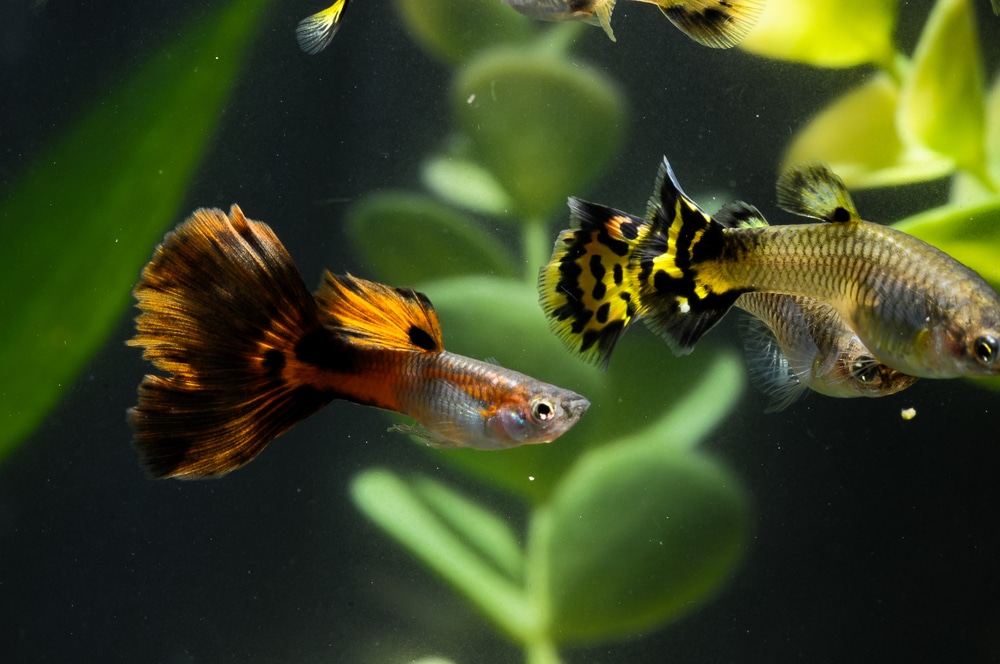
Guppies need little introduction as most aquarists have kept them at one time or another. Guppies are Livebearers and possibly the most popular of the group. Guppies are peaceful Dither Fish, tolerant of a wide range of water conditions, and will eat whatever you provide them.
Sexing Guppies is also very easy as males are far showier in color and finnage. However, you should always include at least one female per male. The males will compete with each other and display constantly in attempting to breed with her and babies are inevitably the result. Guppy fry will usually be eaten in a community aquarium but a few invariably survive to adulthood over time.
- Average Length: 1-2″
- pH Requirements:5-7.8
- Water Column: Lower to Middle
- Species to Consider: Common Guppy, Endler’s Livebearer
- Special Considerations: Also called Million Fish, Guppies will breed continually so long as they are well fed. Raising the young requires a separate tank and specially selected foods for their tiny mouths but is easy to do and rewarding.
Medium Sized Dither Fish Species
Here are a few types of dither fish that fall in the medium/moderate size range:
Barbs
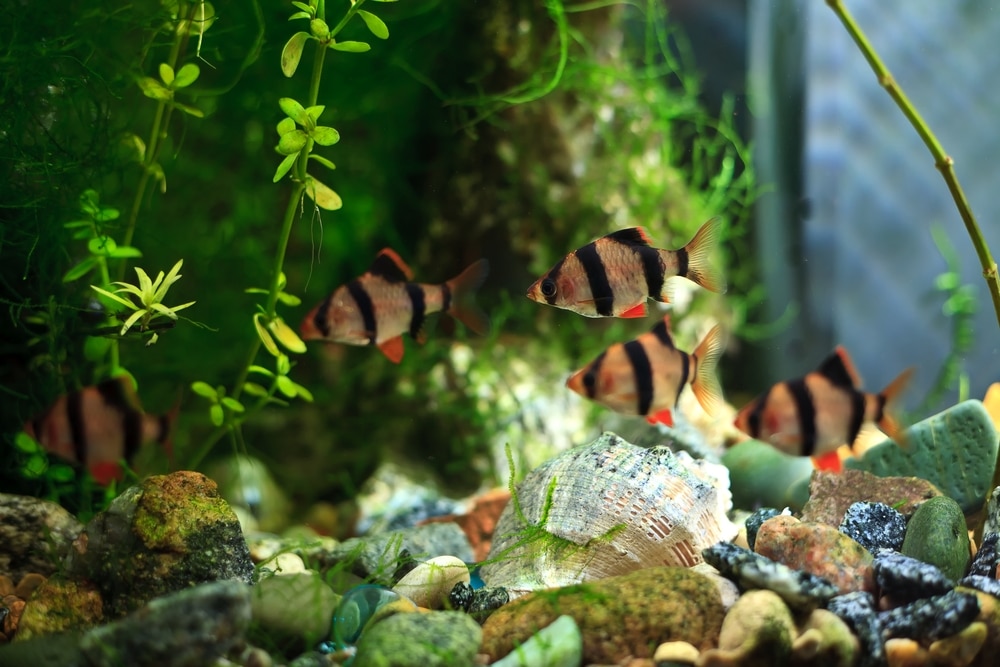
Barbs are Cyprinids from Southeast Asia. Barbs are significantly larger than Danios and chunkier in form. They are all fast moving, schooling fish and include several popular aquarium fish. Tiger Barbs come in several color morphs and many other species are naturally intense in color.
Most Barb males are slightly smaller but more intensely colored than females. This is especially true of Black Ruby and Cherry Barbs. While Cherry Barbs are excellent small Dither Fish, most of the other species are large enough to act as Dither or Target fish for medium sized Cichlids and other aggressive species. Make sure you provide at least 20 gallons of space for these fish as Barbs are active, chunky fish that school and thus have a significant bioload.
- Average Length: 2-5″
- pH Requirements:0-7.5
- Water Column: Middle
- Species to Consider: Tiger Barb, Gold Barb, Black Ruby Barb, Rosy Barb, Spanner Barb, Denison Barb, Cherry Barb
- Special Considerations: Barbs aren’t aggressive but have a tendency to nip at the tempting, flowing fins of slow moving fish like Bettas, Guppies, and Angelfish. This will cause stress and leave routes for infections to take hold.
- My Recommendation: Black Ruby Barb
Black Ruby Barbs are not as popular as their cousin the Tiger Barb but they really should be. Males need to be kept with females in order to show their best color, taking on an intense purple and ruby red color mixed with iridescent spangles. Black Ruby Barbs are on the small side, rarely growing past 2 inches. They are also peaceful and rarely nip fins.
Giant Danio
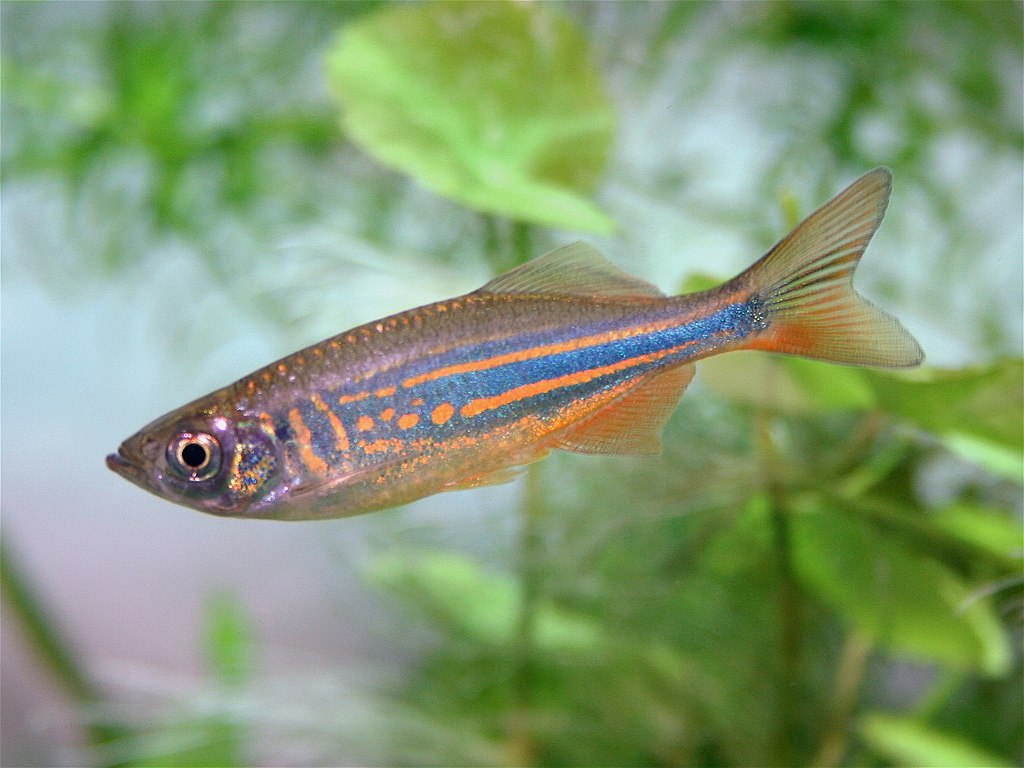
Most Danios are small fish suitable for even nano aquariums. Giant Danios are the exception; males regularly reach 3 inches and females can top 5 inches! This makes them excellent Dither Fish for medium sized aquarium fish. Giant Danios are incredibly fast and schooling fish; this makes them aggravating when you need to catch one in a net but they are excellent Target Fish as a result.
Giant Danios should be kept in spacious, long aquariums of at least 55 gallons at maturity as they tend to race back and forth continually. You should have at least 6 in order for them to feel secure; even Dither Fish need Dither Fish! Like all Danios, Giant Danios will accept anything offered and are very undemanding in terms of water chemistry.
- Average Length: 3-5″
- pH Requirements:0-7.5
- Water Column: Middle to Upper
- Special Considerations: Long style aquariums are preferred to squat designs. This gives Giant Danios room to swim without having to make constant abrupt turns.
Silver Dollars
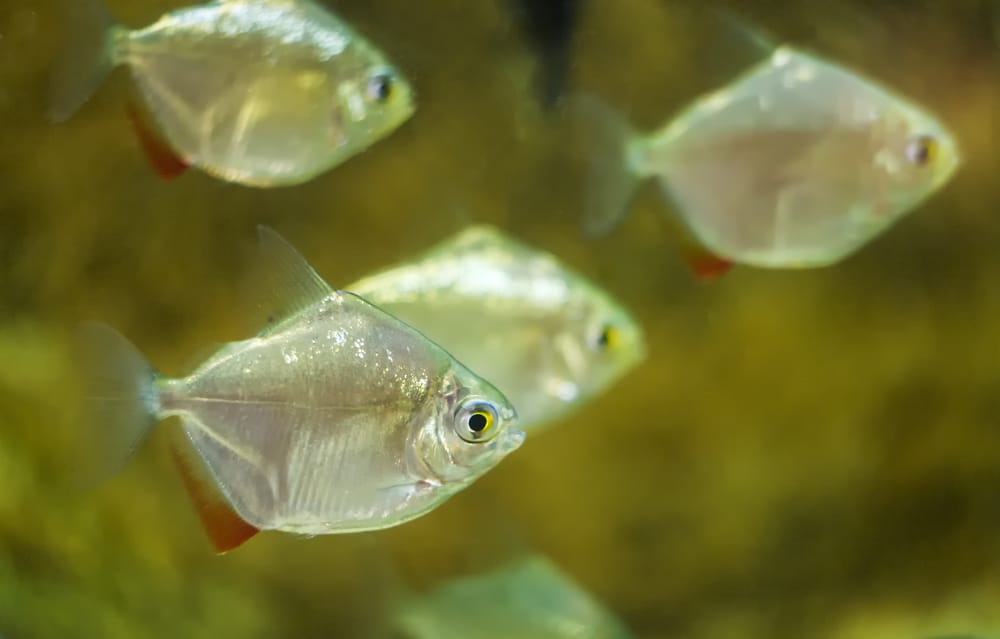
The Silver Dollar is a member of the Serrasalmidae family, which includes both Pacu and Piranhas. All Serrasalmidae are medium to large schooling fish from South America that are close kin to Characins. This means they prefer warm (75-83F), acidic waters, but they are hardy and can be acclimated to slightly alkaline pH levels as well.
Like their larger cousins the Pacu, Silver Dollars are mostly vegetarian. They move in groups of dozens to hundreds in nature, feeding on soft water plants and relying on the confusion of their mirrored flanks and fast, darting movements to avoid Amazonian ambush predators.
Silver Dollars will accept flakes and pellets but should be regularly given blanched vegetables like zucchini slices, spinach, and cauliflower. They have powerful, crunching teeth and will take large bites out of any aquatic plants you provide, even plants normally immune to vegetarians like Anubias and Java Fern.
They are peaceful fish but given their size, schooling tendency, and active nature, Silver Dollars should never be kept in aquariums smaller than 125 gallons. If kept as Target Fish, you should expand that to 180 gallons to ensure they can actively evade a short chase from aggressive tank mates without crashing into the aquarium glass.
- Average Length: 6-8″
- pH Requirements:0-7.0
- Water Column: Middle
- Species to Consider: Red Hook Silver Dollar, Spotted Silver Dollar, Common Silver Dollar
- My Recommendation: Red Hook and Spotted Silver Dollar
Silver Dollars are mostly identical in care needs and size. Red Hook and Spotted Silver Dollars offer a bit of added color that the Common Silver Dollar (Metynnis argenteus) doesn’t have.
Rainbowfish
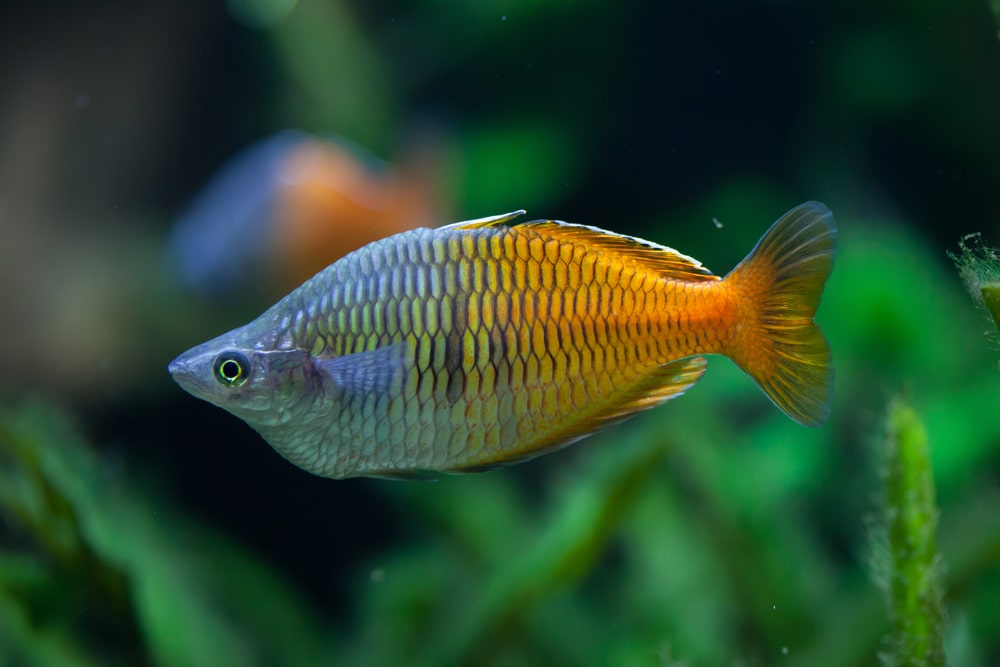
Rainbowfish are a family of boldly colored, hardy fish that aren’t nearly as popular in the aquarium trade as they should be. Of the family Melanotaeniidae, they come from Madagascar, Indonesia, and Australia, and range from an inch to nearly 6 inches in size. They tend to have an iridescent sheen that makes them particularly eye catching under bright light.
Rainbowfish are schooling fish that are sexually distinct; males are always brighter in color and many species also have flowing fin extensions that females lack. Many are deep bodied fish compared to other Dither Fish and they are tolerant of an especially wide range of water chemistries. Rainbowfish can work as Dither Fish in both a slightly acidic community aquarium as well as Target Fish in an alkaline Rift Lake Cichlid environment.
As active carnivores, Rainbowfish should be given a mixture of prepared and frozen foods. Bright invertebrates like brine shrimp and bloodworms will give them better color, especially species with golds and reds like Bosesman’s and Red Rainbowfish. Dwarf species such as the Celebes Rainbowfish are great Dither Fish for smaller community aquariums.
- Average Length: 1-6″
- pH Requirements:0-8.0
- Water Column: Middle to Upper
- Species to Consider: Boeseman’s Rainbowfish, Red Rainbowfish, Irian Jaya rainbowfish, Banded Rainbowfish, Lake Kutubu Rainbowfish
- Special Considerations: Rainbowfish are often named for where they are from (Irian Jaya, Celebes, Lake Kutubu). This can offer insights into their care requirements. Many are wild caught and exceptionally rare, which drives up their price.
- My Recommendation: Boeseman’s and Red Rainbowfish
These two species are some of the most popular Rainbowfish in the aquarium trade. Boeseman’s Rainbowfish grows to around 4 inches while Red Rainbowfish can reach up to 6 inches. Females are a drab brown compared to males but are needed if you want to see best color from them. When given a spacious aquarium of 55+ gallons they make excellent Dither and Target Fish for medium to large tank mates.
Large Types of Dither Fish
Here are a few dither fish species that are a bit larger:
Tinfoil Barb
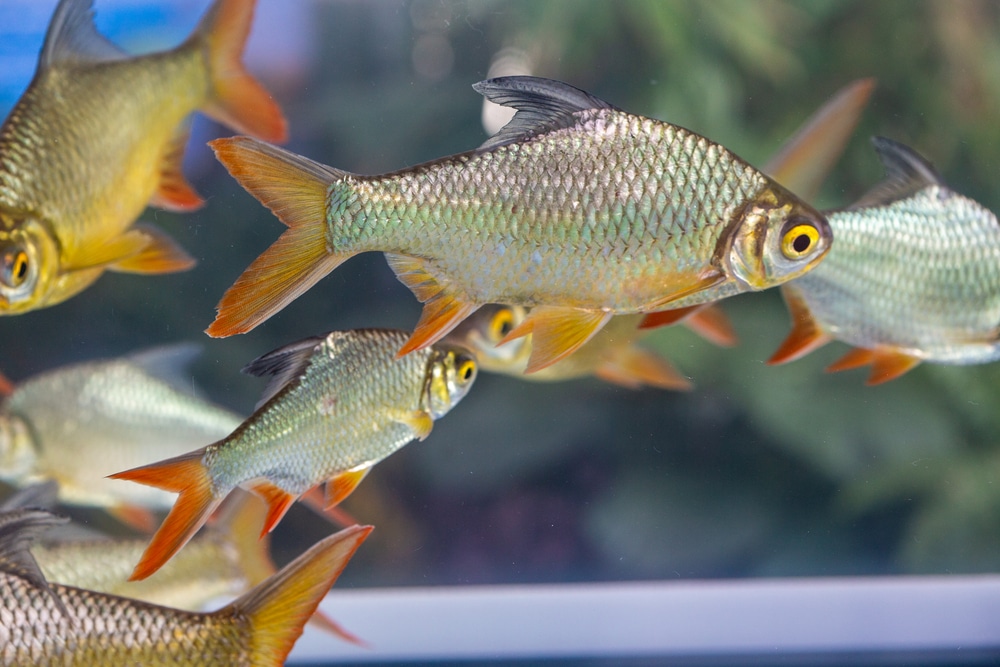
Tinfoil Barbs are some of the largest Barbs in the world but should be treated identically to their smaller cousins. They come from Southeast Asia and Northern Indonesia where they are occasionally raised for food as well as the aquarium trade. Reaching over a foot in length, Tinfoil Barbs live up to their name, with a glossy sheen that easily catches the light accented by red fins.
Tinfoil Barbs are schooling fish with omnivorous tendencies. However, they consume more plant matter than most and should be provided blanched vegetables and vegetarian flakes in addition to protein-based prepared and frozen foods.
Like all Barbs, Tinfoil Barbs have the tendency to nip at the trailing fins of slow moving fish. They will also pick at fish significantly smaller and can even consume tiny fish like Tetras when mature. While not aggressive they are opportunists so tank mates should be chosen with care.
- Average Length: 10-14″
- pH Requirements: 6.0-7.5
- Water Column: All
- Special Considerations: Tinfoil Barbs are both large and extremely active. A spacious tank with a tight-fitting lid is essential as a foot long TInfoil Barb can leap free of a standard aquarium hood with ease when panicked.
Bala Shark
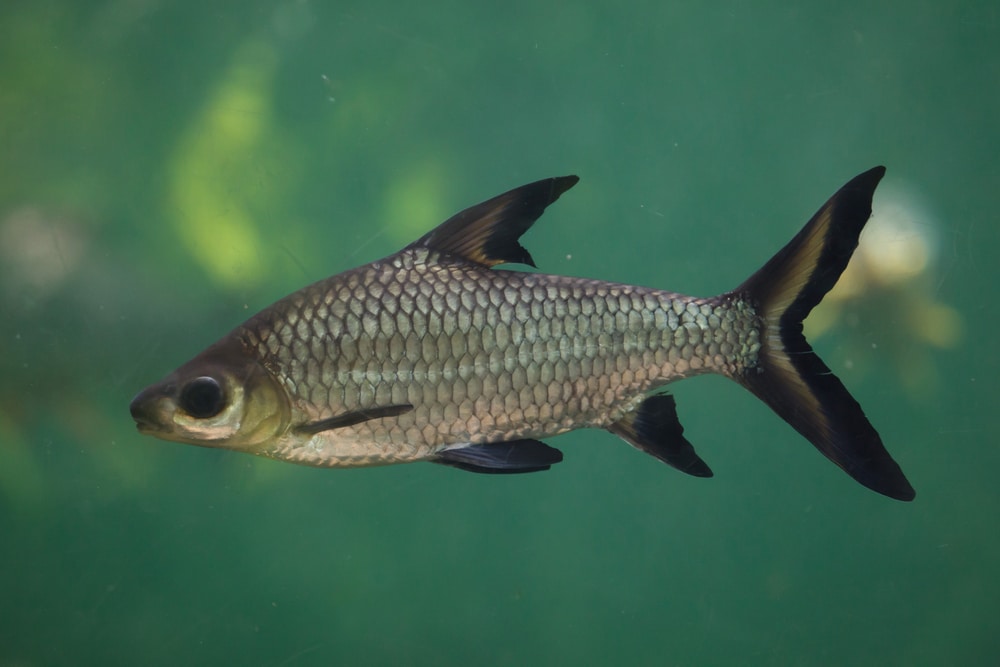
Bala Sharks are not true sharks. Rather they are freshwater Cyprinids and related to Barbs and Goldfish. Unlike Barbs, Bala Sharks can grow to be a foot or more in length but don’t share their opportunistic, fin-nipping nature.
These Indonesian gentle giants eat plankton and tiny invertebrates in the wild but will happily accept whatever’s offered in aquariums. Bala Sharks are inexpensive Dither and Target Fish that grow rapidly but should be kept in schools of 6 or more. When kept singly they grow even more skittish and liable to slam into tank walls and hoods.
- Average Length: 10-14″
- pH Requirements: 6.0-7.0
- Water Column: Middle to Upper
- Special Considerations: Bala Sharks should only be kept in the largest of aquariums as adults (180+ gallons). They are fast, active fish that need plenty of space to swim and turn about without running into glass or objects.
Pacu
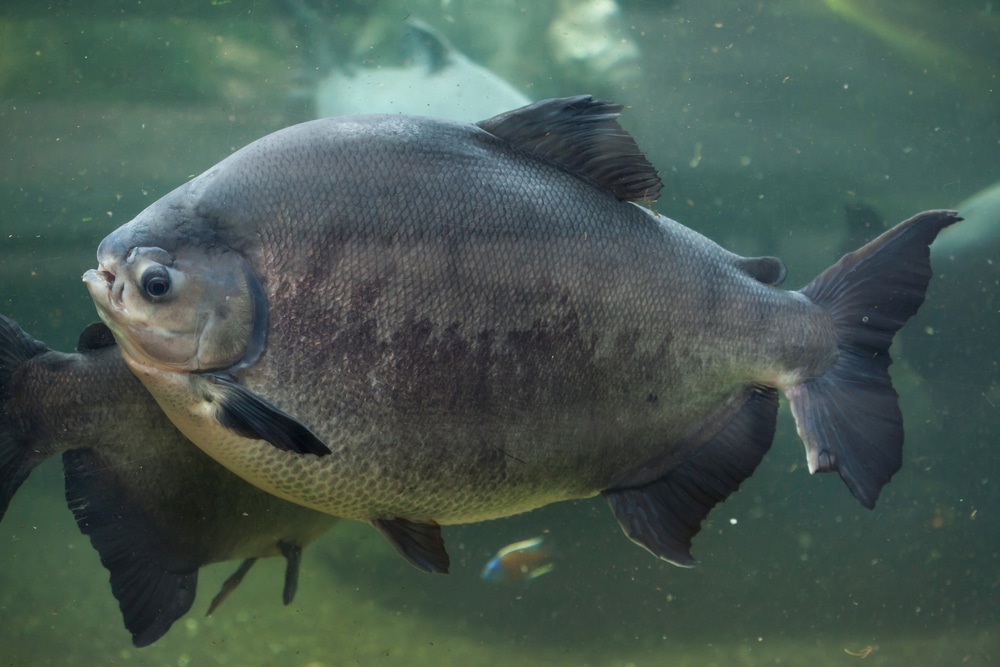
Pacu are the largest members of the Serrasalmidae family, which includes Silver Dollars and Piranha. Pacu are the largest commonly available Dither and Target Fish in the aquarium trade. You can expect your Pacu to reach at least 2-3 feet and weigh as much as 40 lbs when mature!
Like all Serrasalmidae they have well developed teeth; in the case of Pacu they look eerily like human incisors and molars. These flat, broad teeth allow them to crunch fallen fruit and nuts as well as leaves and water plants. In the wild, Pacu move in lazy schools of dozens like fat water cows grazing through flooded Amazonian forests.
Given their size they aren’t especially quick and should not be used as Target Fish save with fish equally large and slow to charge. Pacu make excellent Dither Fish but need tanks in excess of 300 gallons or heated ponds in order to thrive. While usually kept singly, Pacu are naturally schooling fish and appreciate being kept in groups.
- Average Length: 24-36″
- pH Requirements: 6.0-7.5
- Water Column: Middle
- Species to Consider: Red Belly Pacu, Black Pacu, Small Scaled Pacu
- Special Considerations: Pacu are gigantic vegetarians and create a massive amount of fecal matter. They are a strain on any filtration system and make regular water changes critical for all aquarium inhabitants.
- My Recommendation: Any

